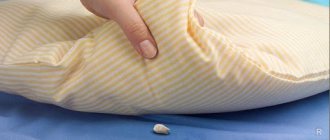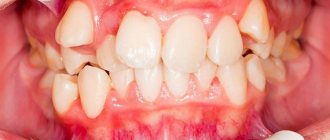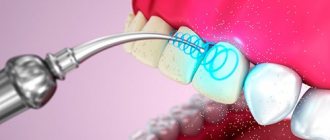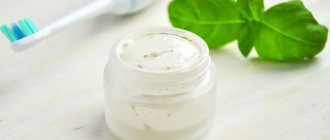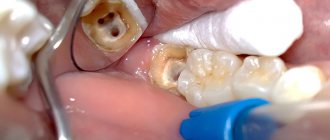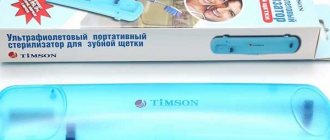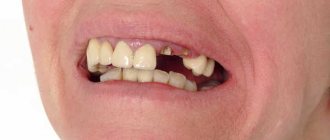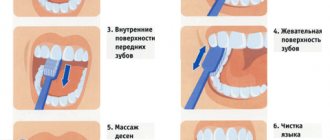How dental plaque is formed
When answering the question of why tartar forms, it is important to immediately clarify that it is the result of the gradual hardening of soft bacterial plaque. It accumulates on the teeth and in the subgingival area and requires regular cleansing with a brush and paste. Unfortunately, even with conscientious oral care, it is not possible to efficiently remove all bacteria and food debris. To enhance hygiene, experts recommend using antibacterial rinses and irrigators. And full-fledged prevention of solid deposits requires mandatory passing of the prof. hygiene at least twice a year.
The plaque that remains after brushing in hard-to-reach places hardens over time and turns into dental plaque - a professional approach is required to combat these processes. Tartar contains compounds of iron, calcium and phosphorus, so it is very firmly attached to the surface of the enamel and is difficult to remove. As for why this phenomenon is dangerous, it should be noted that accumulating mainly in the subgingival area, pollution soon provokes inflammatory processes and inevitably leads to the gradual destruction of hard tissues and the development of carious processes.
Special toothpastes –
Such pastes remove dyes, pigment plaque, and partially mineralized microbial plaque from the enamel surface. This occurs due to the use in the composition of such pastes -
- abrasive and polishing components,
- enzymes (bromelain, papain), polydon® and pyrophosphates, which loosen pigmented and microbial plaque, thereby facilitating its removal by abrasive components.
However, the capabilities of such pastes are significantly limited. Such pastes will not allow you to remove massive pigment plaque and dental plaque (as in Fig. 1-3), but they can cope with a moderate amount of it and a small superficial dental plaque. Intensive whitening pastes with a high abrasiveness are especially effective here.
Toothpaste “PRESIDENT White Plus” –
instructions for use- controlled abrasiveness – RDA 200 ,
- active ingredients: abrasive and polishing components (silicon dioxide and diatomite), calcium glycerophosphate,
- applied only once a week,
- price: 30 ml – from 230 rubles.
Toothpaste “LACALUT White” –
instructions for use- controlled abrasiveness – RDA 120 ,
- active substances: abrasive and polishing components (hydrated silicon dioxide and titanium dioxide), pyrophosphates, sodium fluoride,
- fluoride content: 1357 ppm
- price: 50 ml – from 240 rubles, 75 ml – 300 rubles.
Before buying and using these toothpastes, read our article on important aspects of using whitening toothpastes: → “Rating of teeth whitening pastes, tips for use”
Why does a stone appear - the main reasons
The main reason is insufficient care of teeth and the oral cavity in general. After eating, small food debris gets stuck in hard-to-reach places and provokes the growth of pathogenic microflora. Bacteria, reacting with saliva and the moist environment of the oral cavity, form plaque on the surface of the enamel. While it is still soft, it can be removed with a brush and paste. But if this is not done in time, it will quickly harden and turn into tartar, and it can only be removed in dentistry.
Insufficient oral care leads to the appearance of dental plaque
Listed below are only the main provoking factors leading to abundant hard stains on the enamel and under the gum:
- irregular cleaning or violation of the technology for its implementation, incorrectly selected hygiene products, lack of comprehensive prevention,
- metabolic disorders, which leads to accelerated mineralization of plaque,
- abnormalities of the bite and position of the teeth, which creates favorable conditions for the rapid growth of pathogenic microflora,
- abuse of foods and drinks with coloring pigments, including strong coffee and tea.
Smokers and patients with diabetes are at increased risk. In their case, the process of formation of hardened deposits occurs faster than usual. There can be only one answer to the question of what to do in such a situation - proper prevention requires a comprehensive approach and regularity in carrying out hygiene procedures.
Plaque cleaning
Considering the fact that plaque formation occurs not just daily, but hourly, its removal must also be systematic. The easiest way is to develop an automatic habit of brushing your teeth after each meal and perceive it as the logical conclusion of the meal.
Brushing with a mechanical or electric brush in the morning and evening can be effective; it is better to supplement it with regular mouth rinsing during the day. These simple skills will ensure, at a minimum, the removal of soft plaque that does not adhere tightly to the teeth and gums.
The same natural help is provided by hard foods, which must be purposefully included in the diet. Vegetables and fruits with hard peels will not only provide vitamins and fiber, but will also mechanically remove plaque. After this, all that remains is to rinse your mouth with water as usual to wash away the acid.
Visiting the dentist twice a year is also a good habit that can prevent future dental problems. Even if you observe daily dental etiquette, there will be a risk of damage to enamel and gums, including genetics.
A good dentist will promptly clear plaque from the enamel using ultrasound or laser, painlessly and effectively. Mechanical cleaning methods, which were not only painful, but also risky for the tooth surface, are practically a thing of the past.
Even probing the gums to find and clean tartar deposits is done under local anesthesia and does not cause significant discomfort. A good dentist will regularly carry out preventive procedures for the gums, improving their blood circulation and getting rid of harmful microorganisms.
Such simple and understandable rules will help keep the plaque problem under control.
What are the dangers of heavy hardened deposits?
Plaque in the initial stages does not cause any discomfort. This is one of the reasons why many patients do not understand why they should go to the dentist and ignore brown spots that first appear on the back surface of the teeth and do not in any way affect the appearance of the smile. But this is the biggest mistake, because deposits provoke caries, lead to the destruction of dental tissue and the development of inflammatory diseases in the gums - gingivitis, periodontitis and periodontal disease. It is better to prevent such a situation than to count on the fact that nothing like this will happen in your case.
The photo shows advanced periodontitis
Causes of the disease
Stone is mineralized deposits that form as a result of poor hygiene. This is the main reason for the formation of tartar. The mechanism of its appearance is as follows: insufficient cleansing of the enamel provokes the accumulation of plaque, the latter hardens and mineralizes.
Note! Partial mineralization occurs within 10–15 hours, complete mineralization occurs within a week, the formation of a full-fledged and very hard plaque takes from 4 to 5 months. But regardless of the stage, hard deposits are equally dangerous for teeth and gums.
Irregular or insufficiently high-quality oral hygiene, violation of teeth brushing technique are the main reasons. But these factors can also be aggravated by others:
- using unsuitable hygiene products on a regular basis: for example, soft-bristled brushes and pastes with an abrasiveness lower than 50 units. Such products are not able to cope with plaque,
- consumption of carbonated drinks with high sugar content,
- ingestion of sweet1 foods, sticky foods (caramel, toffee, cookies, etc.), which are difficult to remove from the surface of the teeth and from the interdental spaces,
- refusal to eat hard, tough foods (carrots, apples), because they allow natural cleansing of the enamel,
- unbalanced diet and lack of vitamins,
- bad habits – alcohol abuse, smoking,
- violation of the pH level of the oral cavity: increased acidity leads to excess salts in saliva, which then provoke mineralization of plaque. The pH level can be disturbed by long-term use of medications, diseases of the gastrointestinal tract, consumption of certain foods,
- regular use of certain medications that increase the viscosity of saliva and the volume of its secretion,
- chronic diseases leading to impaired mineral metabolism, diabetes mellitus,
- untimely restoration of missing teeth: people with this problem use mainly one part of the jaw to chew food, while the second is subject to excessive accumulation of plaque,
- dry mouth (xerostomia) or, conversely, increased salivation (hypersalivation).
Risk factors are also some structural features of the dental system: malocclusion, disturbances in the tone of the masticatory muscles, row defects (lack of teeth).
Types of Tartar
The first sign of stone formation is pigment spots on dark-colored enamel. Next, bad breath appears, the gums may turn red and bleed during brushing. If you continue to ignore these pathological phenomena, sooner or later pain will appear. Let's take a closer look at this process.
The photo shows the types of tartar
Supragingival deposits
At the initial stage of its formation, plaque has a loose structure. First, it appears on the surface of the enamel and is the result of waste products of pathogenic microorganisms. Mainly localized on the back side of the teeth in the supragingival region. Because of this, the enamel acquires a yellowish tint. Such contaminants can still be removed using home methods.
If loose supragingival plaque is not removed in time, it will turn into hardened deposits, that is, it will mineralize. In this state, it adheres very tightly to the enamel, appears in the form of dark brown spots, and cannot be removed with standard cleaning.
2. Hard accumulations in the subgingival area
At the next stage, deposits begin to accumulate in the subgingival area - there is practically no loose plaque there. This process leads to the formation of periodontal pockets, which subsequently provokes more serious problems - caries and inflammation of the mucous membrane.
“A year ago I started having bad breath. I've tried everything! Expensive mouthwashes, pastes, and folk recipes - nothing helped. And most importantly, the teeth looked clean and relatively white. As a result, I made an appointment with the dentist for a cleaning and it turned out that I had tartar under my gums. It even smelled, so nothing helped. After removing the deposits everything went away. Now every six months I go through the prof. hygiene, and as soon as I remember that period, it became so bad!”
LubashaS., from correspondence on the woman.ru forum
Such contaminants can only be removed from under the gums in dentistry, and for this, doctors use special softening compounds and tools.
Symptoms and signs
Many of us do not notice the symptoms of tartar, considering them to be the norm. Darkening of the enamel, yellow and brown plaque, bad breath, a feeling of uncleanness even after brushing your teeth - all this is a reason to look carefully in the mirror and find small cloudy seals near the teeth that have almost become part of the tooth itself.
Since tartar bothers many people, dentists sometimes don’t even mention it at a preventive appointment: they say, you can see it yourself. “But this is not caries, the teeth are intact, nothing hurts,” the patient himself thinks, disagreeing with the need for professional cleaning. This is how a vicious circle starts, leading to many oral diseases.
How to clean teeth in dentistry
To clean the supra- and subgingival area and get rid of the stone, it must be softened and carefully removed. You need to deal with this problem wisely, without counting on the help of traditional medicine. Previously, in dentistry, only mechanical cleaning was used for this - cleaning was carried out using special hooks. Today, modern technologies are used for this purpose: ultrasound, laser, sandblasting and other techniques - let’s look at them in more detail.
Mechanical cleaning
Today, this method is more often used as an auxiliary method if, for example, it is necessary to remove dirt from the subgingival area. Using special tools in the form of hooks, the doctor carefully pries them up, separates them from the surface of the enamel and removes them from the oral cavity. The procedure is quite painful, so it is often necessary to use superficial anesthesia.
The photo shows the procedure for removing plaque from the subgingival area of a tooth.
Using ultrasound
The use of an ultrasonic scaler (skyler) is considered one of the most effective methods in the fight against hardened dental plaque. The device creates vibrations and vibrations of a certain frequency, which have a destructive effect on fossils, without injuring hard tissue. As a result, the stone is literally destroyed into tiny particles, which are immediately removed from the oral cavity by an air-water jet. Due to the effect of cavitation, that is, strong turbulence of the liquid, direct contact of the device nozzle with the surface of the teeth is excluded1.
Important! After such cleaning, the main factor that provokes inflammatory processes in the gums is eliminated. However, the correct prof. hygiene requires comprehensive care of teeth and soft tissues of the oral cavity. Therefore, for the restoration of gums, it is also important to treat them with antimicrobial solutions and regenerating hydrogels. In some clinics, as part of this procedure, a self-resorbable collagen membrane is also applied, which nourishes the tissues with beneficial substances contained in medicinal plant extracts.
The procedure usually does not cause serious discomfort, but with increased sensitivity of the enamel it can provoke moderate pain. Therefore, sometimes an anesthetic gel is applied to the mucous membrane to reduce discomfort. Ultrasonic cleaning is often combined with Air Flow sandblasting - read more about this technique below.
Using an ultrasound machine, a specialist cleans periodontal pockets
Air-Flow Sandblasting
Air-Flow technology involves a powerful supply of air-water jet with the addition of abrasive particles. The mixture is fed through a special nozzle and provides high-quality sandblasting of the surface of the teeth. This is an effective way to remove pigmented areas. This technology is often used as an auxiliary technology for ultrasonic cleaning. With its help, you can efficiently remove plaque residues from hard-to-reach places, grind and polish the enamel.
The photo shows the method of brushing teeth with the Air Flow system.
Laser enamel cleaning
A laser is also used to combat hardened stone. This method is not as popular as ultrasonic cleaning, but it is somewhat more expensive due to the considerable cost of the laser installation itself. Under the influence of the beam, fossilized deposits are crushed. At the same time, the laser allows you to create a targeted effect, which significantly reduces the risk of overheating of hard tissues and eliminates any unpleasant sensations.
The essence of the method is to activate the gel with a directed laser beam
Chemical etching
This technology is used as additional cleaning, like the Air Flow air-abrasive technique. In this case, the deposits are treated with special preparations that contain acids and alkalis. With the help of such products, hardened areas are softened, which facilitates their further cleansing. With the advent of ultrasound and laser technologies, this method faded into the background, and today it is used extremely rarely.
The photo shows chemical teeth cleaning
Curettage of periodontal pockets
In complex advanced cases, gum curettage is prescribed. This procedure involves thorough cleaning of periodontal pockets, sometimes with simultaneous bone tissue building. This is the most important stage in the complex treatment of periodontitis and periodontal disease. Closed curettage is performed if the depth of the pockets does not exceed 5 mm. Deposits are removed using ultrasound and special hooks.
This is how open curettage is performed on the mucous membrane
Open curettage is a full-fledged operation, which is prescribed when the pocket depth is more than 5 mm. The procedure is performed under local anesthesia and involves cutting the gum to expose the root. Next, the doctor removes pathogenic microflora, carries out antiseptic treatment, and polishes the root. If necessary, bone replacement chips are transplanted to restore the condition of the bone tissue.
How to get rid of tartar in the clinic
In dentistry, there are 4 methods of cleaning teeth from hard deposits, which differ in the principle of their effect on plaque.
- Chemical . Active substances are used that can dissolve mineralized sediment. These are mainly acid and alkaline mixtures. The procedure is carried out by an experienced dentist, since the preservation of the health of the gums and enamel depends on the selection of the concentration of solutions.
Before and after tartar cleaningUltrasonic . A scaler is used - an ultrasonic device. Vibration waves form powerful vortices on the tooth surface, which crush hard deposits. This method of removing stones from teeth is the safest. The nozzle of the device does not come into contact with the tooth and therefore cannot harm it, unlike the same chemicals. But before using an effective dental method, you need to make sure there are no contraindications: diabetes and cardiovascular diseases.
- Laser . The same principle is used as with the ultrasonic method. However, the high cost of the equipment has made the laser cleaning method less widespread.
- Air Flow or air-abrasive . This method of removing tartar involves treating the enamel with a solution of abrasive substances under pressure. It is rarely used as an independent method. Typically, the bulk of deposits are removed using a scaler, and the result is fixed using an air-abrasive method. Alone, it can be used in the early stages of stone formation, to remove pigmentation, polish enamel, as the final stage of teeth whitening, and also to cleanse the oral cavity of hard-to-reach soft plaque.
- Mechanical . The deposits are dissolved using special means, after which they are cleaned with dental instruments: spatulas, hooks, files. This method of cleaning tartar is the most traumatic, therefore it is outdated and used extremely rarely.
Methods for removing tartar, video:
None of the methods is used in dentistry without first checking the condition of the gums and teeth. If necessary, anti-inflammatory therapy is carried out before cleaning, and in the presence of caries, filling is carried out.
What will help clear plaque at home?
Many people ask questions about whether it is possible to quickly remove tartar on their own at home. In fact, hardened deposits can only be removed during professional cleaning, using special tools and compounds. But you can provide proper prevention at home. While the plaque is still soft or in the initial stages of hardening, it is possible to remove it yourself. There are many folk remedies on this score, but there is an important nuance: they can be used in practice only after visiting a doctor and his professional assessment of the condition of the enamel. The most effective and safest recommendations are described below.
Black radish recipe
If the plaque has already hardened, the problem needs to be treated in dentistry. But while it is at the initial stage of mineralization, there is still a chance to stop this process on your own. Regarding what can be used to remove it at home, experts in folk recipes recommend radish in combination with lemon juice. The acidity of citrus fruits and the bitterness of radish gives an abrasive-chemical effect. To prepare the product, you need to grate the radish, after peeling it. Then add lemon juice. It is recommended to chew the finished salad thoroughly and then spit it out - this procedure is best done after evening hygienic cleaning.
Black radish with lemon helps to cope with plaque
Horsetail decoction
To prepare the decoction, you need to take three tablespoons of the dried plant and pour a glass of boiling water. Next, the container should be tightly closed and insulated. Wait until the broth cools down and strain. Next, it is recommended to use the product for rinsing in the morning and evening - about half a glass for one procedure.
Honey rinses
Effectively softens plaque, including honey. It is enough to take one tablespoon of natural honey and dilute it in a glass of warm water, stirring well. The solution can then be used for rinsing every evening after hygienic cleaning. As a preventative measure, it is recommended to repeat the procedure within a month.
Honey dissolved in water softens dental plaque well.
Walnut bark
The bark of walnut branches has proven itself to be excellent in the fight against stains on teeth. Two tablespoons of dry raw materials should be poured with cold water and placed on low heat for a quarter of an hour. Then the resulting mixture can be used to brush your teeth twice a week - 3-5 minutes per procedure.
Walnut peel is also used in the fight against plaque
Burdock root and bean husk
To prepare the product, you should take several dry bean pods and a tablespoon of burdock root - the latter must first be crushed. Pour all the raw materials into one container, add water and then boil for two hours. Then the broth should be filtered and used for rinsing 4 times a day.
Saline solution and paste
To prevent the formation of stone, from time to time you can use simple table salt to brush your teeth - it perfectly softens hardened plaque. But you need to be careful not to press too hard on the brush, otherwise you can easily damage the enamel. As an option, you can use a saline solution for rinsing - just dilute a teaspoon of salt in a glass of warm water and use it as directed.
Citrus fruit
Citrus juice also effectively softens plaque and helps remove it. Lemon and grapefruit are especially good in this regard. You can simply diversify your daily diet with these fruits or from time to time brush the surface of your teeth with a slice of lemon or grapefruit. Only after such a procedure is it advisable to brush your teeth with toothpaste, otherwise the acid will continue to corrode the enamel.
Citrus juice helps soften and dissolve plaque
Methods for removing deposits from enamel
There are several types of procedures to help get rid of tartar. They differ in the method of influencing education:
1) Physical
The method involves mechanical destruction of the layer, which until recently was carried out using dental instruments with a pointed tip. The Air flow technique is now widely used, when a stream of air is supplied under pressure, delivering sodium bicarbonate to the contaminated area. The soda crushes the plaque, and the subsequent stream of water washes away the broken pieces.
2) Chemical
Involves the use of aggressive chemical compounds to dissolve salt formation. The teeth are treated using a cotton pad, which is moistened in the solution. Softened stone is much easier to remove, and the gums and enamel are subjected to minimal pressure.
3) Exposure to ultrasound
Separation of fossilized plaque using ultrasonic waves allows you to preserve the integrity of the enamel and not damage the gums. This method cannot be used for patients who have a pacemaker installed, so as not to provoke a malfunction of the device.
4) Laser radiation
This method is the most expensive, but very effective in the fight against tartar. In this case, a laser beam is used to crush the fossil into small pieces.
How to recognize tartar and distinguish it from caries
Many people wonder how to distinguish caries from tartar. To do this, you can purchase a special coloring composition at the pharmacy. There are such drugs in the form of lozenges or a special mouthwash. After their application, the plaque will be colored, which will allow you to immediately recognize the places where it accumulates the most. Such tests can be repeated periodically for control and prevention.
To distinguish a carious spot from a pigmented area on the enamel, you can purchase a special caries detector. Such preparations contain a substance that stains only the affected areas - plaque and even tartar remain unchanged. Using a cotton swab, you need to apply the composition to the area that is in doubt. If it changes its color, then carious processes are taking place. Such products are actively used in dental practice, but you can also use them yourself - they are sold in pharmacies without a prescription.
A caries detector will help distinguish plaque from enamel damage
Even if such a test shows a negative result, this does not mean that you can simply forget about the dark spot on the tooth. Such deposits require modern removal, otherwise caries will appear soon.
Precautionary measures
When using unconventional methods, you must first of all remember safety. What precautions you need to know and how to remove tartar at home without damaging the enamel.
Caution should be exercised when using household acid-containing products . Concentrated acids are quite capable of breaking down plaque, but they also damage the surface of the tooth.
Folk remedies for tartar may contain components that cause an allergic reaction, so before use you need to make sure they are safe.
Any discomfort, pain, burning, bleeding or other undesirable reactions is a reason to urgently stop all manipulations and make an appointment with a dentist.
Products with abrasive particles give good results, but you should not make multiple attempts to use them to achieve an ideal result. If used incorrectly, abrasives can cause inflammation of the gums and provoke the development of wedge-shaped defects and caries.
Prevention - expert advice
To effectively remove plaque on a daily basis, you need to brush your teeth at least twice a day – morning and evening. It is important to use an individually selected brush and toothpaste for this, and adhere to the correct technique for performing the procedure. It is also recommended to purchase an irrigator - this is a convenient device that supplies an air-water jet under high pressure and thereby allows you to efficiently clean hard-to-reach places. Periodic use of abrasive pastes is also allowed, but only if there are no problems with the gums. It is recommended to use such products in courses, since their too frequent use can lead to problems with the enamel.
An irrigator is an additional device for maintaining oral hygiene
It is important to understand that no home methods will help remove hard deposits - for this you need to visit a professional dental hygienist every six months. hygiene. Regular completion of this procedure will be the best prevention of abundant subgingival calculus and other dental problems.
How to remove tartar using ultrasound and toothpaste?
Many people are interested in the question of whether it is painful to remove tartar at the dentist. It all depends on the method used for removal. Several years ago, almost every dentist had ultrasonic devices in their office that make it possible to remove hard mineralized formations.
How to remove tartar using ultrasound and toothpaste:
- The operating principle of the device is based on the supply of special ultrasonic waves, which destroy the structure of solid formations and help eliminate them. This manipulation allows you to whiten your teeth, make them beautiful and neat.
- Remember that ultrasonic cleaning is very effective among smokers, as it helps remove plaque that accumulates over several years. Many patients are interested in the question, is the procedure painful? In fact, it all depends on the sensitivity of the teeth.
- If the teeth are very sensitive, and tartar has grown, there is a large amount of it in the mouth, it penetrates into the gum pockets, then it is recommended to perform anesthesia. Unlike mechanical cleaning, the ultrasonic method of getting rid of tartar is more gentle and does not damage the enamel. After the procedure, many dentists recommend fluoridation of teeth.
- This is due to the fact that in the process of exposure of teeth to ultrasound, the stone is destroyed, but the enamel becomes porous. Accordingly, it is susceptible to various kinds of destroyers, and can be colored with the help of coffee or some natural juices. That is why do not refuse fluoridation after ultrasonic cleaning.
- Previously, tartar was removed using special means and mechanical action. Simply put, he was scraping off the walls. As patients noted, the procedure was quite painful, because the instrument could get into the gum and cause severe pain.
After such exposure, the enamel is very weakened and prone to plaque accumulation, and the occurrence of tartar increases. Accordingly, new foci of mineralized hard formations very quickly form on cleaned teeth mechanically. The use of ultrasound improves the situation and not only helps remove tartar, but also prevents the formation of new hard areas. The device is called a scaler, and has several attachments. This way you can get rid of both large and small stones. After ultrasonic cleaning, an antiseptic effect is observed, so the procedure is also carried out for periodontal disease.
Treatment
